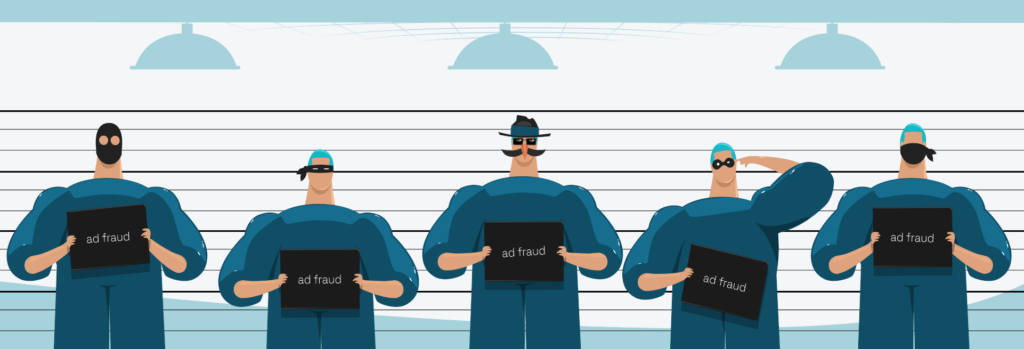7 Types of Ad Fraud and How to Prevent Ad Fraud?
There are many different types of ad fraud–from simple tricks to advanced techniques that require technical resources.
Nevertheless, ad fraud affects all parties involved in the advertising industry–publishers, advertisers, and users, so it’s important to know how to prevent it until it’s too late.
But first, let’s begin by discussing the most common types of ad fraud there are.
Ad fraud is still one of the biggest challenges the digital advertising industry faces. It’s estimated that there will be a $100 bln loss in digital ad spending by 2023 due to ad fraud.
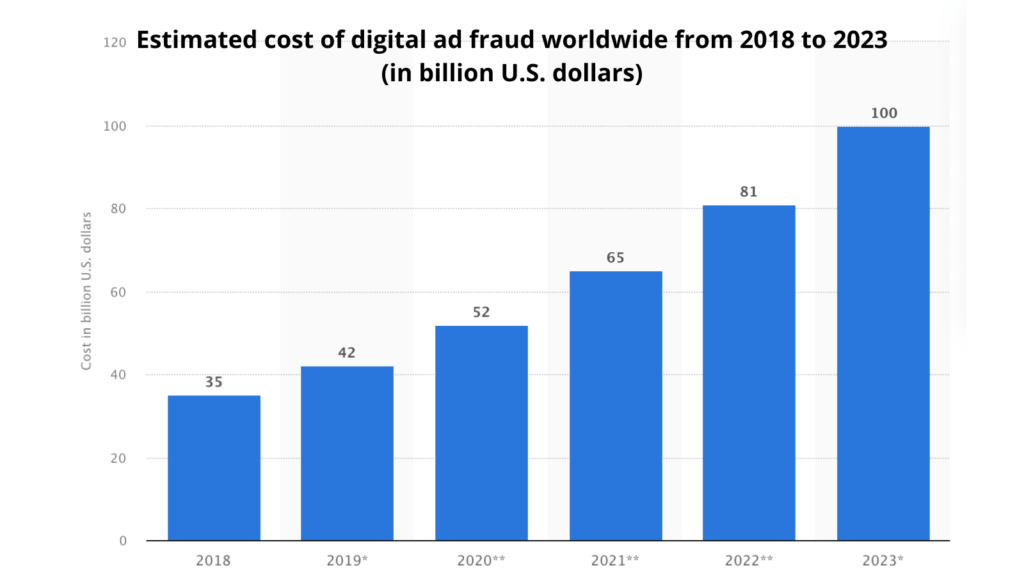
Source: Statista
Types of Ad Fraud
1. Pixel Stuffing
Pixel stuffing means that more than one ad is placed into one single 1×1 pixel area. Usually, when fraudsters use this type of ad fraud, they make money on ad impressions from this pixel ‘ad’.
The worst thing is that users don’t even need to see the ad because it will still count as a viewed impression. Furthermore, this sort of action can be repeated more than once on a single webpage.

Source: Funmobility
2. Ad Stacking
Ad stacking is quite similar to pixel stuffing. But whereas in pixel stuffing, multiple ads are placed in the same area on the page, ad stacking involves placing multiple unviewable ads on top of each other with users only seeing the ad on the top.
This advertising fraud aims to inflate ad impressions. Since ads are put on top of each other, ad impressions are counted for all ads even though they weren’t visible.
3. Domain Spoofing
Domain spoofing is when fraudsters disguise their real URL for a premium website. This means they’re tricking users, advertisers, and the publisher who owns the premium domain.
This is definitely one of the biggest threats for publishers because it allows fraudsters to sell publishers’ ad space for how much they want, leaving the publisher without any revenue.
Domain spoofing can also take the form of scraped content placed on a fake site. The aim here is to make the site look and feel as real as possible so that the website can profit by running ads.
Below is an example of a website that scraped Setupad content and placed it on its website, intending to generate money from ads.
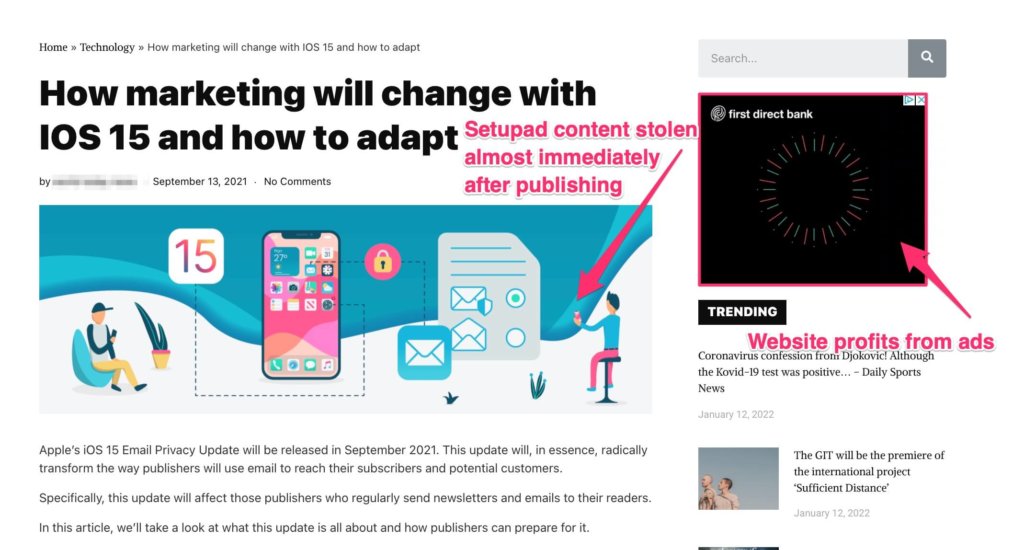
4. Ad Injection
Ad injection means that the ad is displayed on the publisher’s website without permission.
This type of ad fraud can affect existing ad spaces by placing fraudulent ads instead of real ones. Alternatively, it can display ads on the publisher’s website if previously there were none.
One of the examples of ad injection happened in 2014 when Walmart’s website displayed Target’s ad. Walmart would never put its competitor ad on its website, but ad fraudsters would.

5. Click Injection
Click injection is one of the most popular types of mobile ad fraud. In this scenario, fraudsters put malware on users’ devices to inject fake clicks on ads and charge advertisers for these clicks. In reality, the user doesn’t see the ads.
The malware ends on users’ devices through malicious apps that users download. These apps run in the background and invisibly generate ad requests and ad clicks without the user’s knowledge. Android devices are especially susceptible to this practice.
Click injection was responsible for 13.35% of the global mobile ad fraud between January and August 2020.
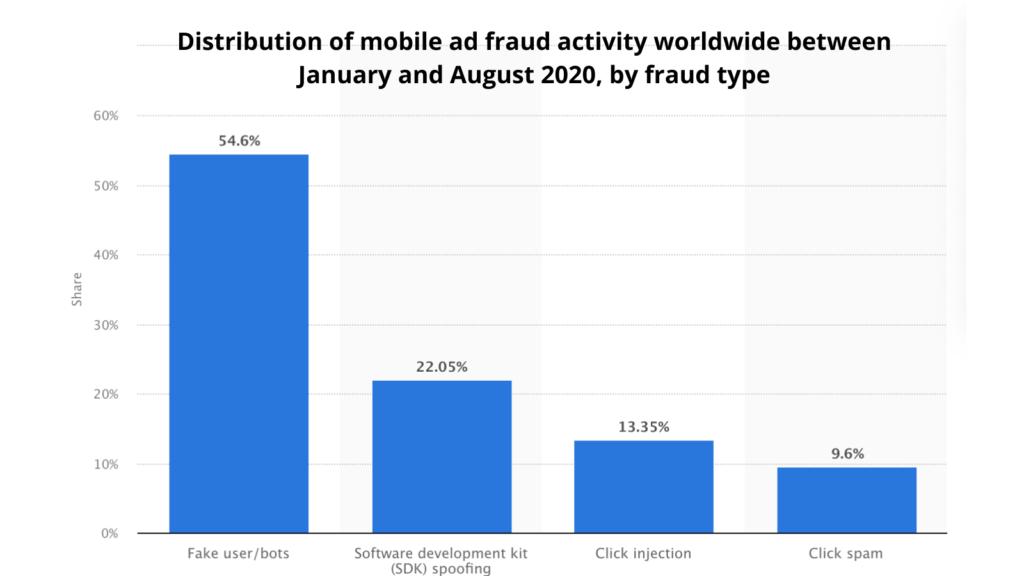
Source: Statista
6. Geo Masking
Geo masking is a technique fraudsters use to make low-quality traffic appear as high-quality, so they can sell it to advertisers for premium prices. It’s done by spoofing the IP addresses of users.
It’s no surprise that traffic in some countries is more valuable than in others. This means traffic from Tier 1 countries like the U.S. and Australia will have higher CPC and CPM than traffic from Tier 2 (Russia) and Tier 3 (India) countries.
As a result, advertisers end up paying 2 or 3 times more money for low-quality traffic.
Related Article: How to Increase Ad Revenue | Success Formula and Proven Solutions
7. Bot Fraud
Bot fraud is another type of ad fraud most often associated with bot traffic. It’s a non-human traffic generated by robots to websites and apps.
Bot traffic represents a significant risk for publishers because it can interfere with websites’ usage, such as phishing or malicious redirects.
If Google notices that the website engages in these practices, it might hide your website from Google Search or label it as dangerous to users.

Click fraud bots can pretend to be legitimate visitors and generate fake clicks on ads. In that case, a publisher’s displayed ads may be easily banned on their monetization program, such as Google AdSense.
How to Prevent Ad Fraud?
- Implement a verification solution: it can help to identify non-human traffic and avoid serving ads while providing transparency to the demand sources.
- Implement ads.txt and sellers.json files: ads.txt file confirms ownership of the publisher’s domain and indicates that partners who buy ad inventory are authorized to do so. Sellers.json file provides a clear picture for publishers of all legal entities involved in the selling process.
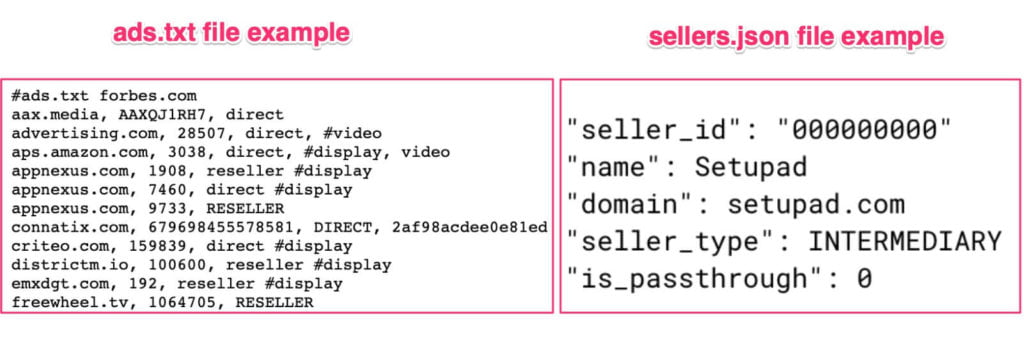
- Use anti-malvertising software: trusted anti-malvertising software like Boltive will protect your page performance from bad actors and prevent malvertising attacks in real-time.
- Use a bot mitigation solution: bot mitigation solutions like Cloudflare have a traffic verification feature. These solutions can distinguish good bots like web crawlers from bad bots that inflate your website with invalid traffic and clicks.
- Work with a trusted monetization platform: Setupad is powered by the strongest anti-malvertising solution and has predefined blocklists by default, so you can be sure your website is in good hands. This service comes at no extra charge.
